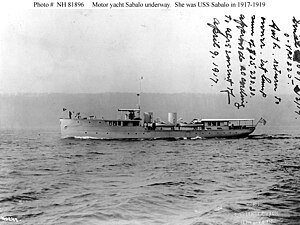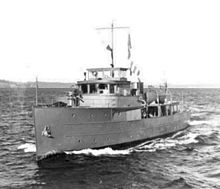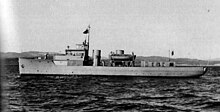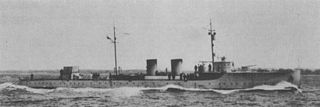
USS Winchester (SP-156) was an armed yacht that served in the United States Navy as a patrol vessel from 1917 to 1919. Prior to and following World War I, Winchester was a private yacht, later renamed Renard. In World War II, Renard was requisitioned for use in the Royal Canadian Navy as a patrol vessel, keeping her name. She was returned to her owners in 1944.
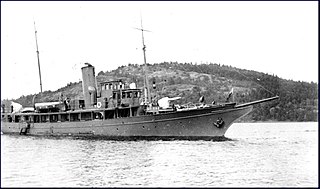
HMCS Florence was a commissioned patrol vessel of the Royal Canadian Navy that served in the First World War. Originally launched as the yacht Czarina, she was acquired by John Craig Eaton in 1910 and renamed Florence. Following the outbreak of war, Eaton donated the yacht to the Royal Canadian Navy. The ship had a short career and proved unsuitable for navy work and was paid off in September 1916. The vessel was subsequently sold to buyers in Martinique, and was reportedly lost in the Caribbean Sea in January 1917.
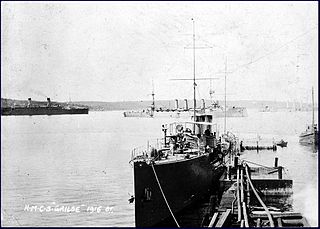
HMCS Grilse was a commissioned patrol boat of the Royal Canadian Navy during the First World War. Launched in 1912 as the private yacht Winchester of the American industrialist Peter Rouss, the vessel was constructed along the lines of a contemporary Royal Navy torpedo boat destroyer. After the outbreak of war, vessels that could be used by belligerents was prohibited by the government of the then-neutral United States. Canadian millionaire J. K. L. Ross purchased Winchester and returned to Canada with the yacht, where he transferred ownership of the vessel to the Royal Canadian Navy. Renamed Grilse, a pseudonym for Atlantic salmon and converted to a patrol boat, the vessel was deployed as part of Canada's east coast patrol combating the German submarine threat. After the war, she was sold back to private interests, re-converted to a yacht and renamed Trillora. Trillora foundered in 1938 at Long Island, New York during a hurricane.

HMCS Hochelaga was a commissioned patrol vessel of the Royal Canadian Navy (RCN) that served in World War I and postwar until 1920. Hochelaga is a historic name associated with Canada, the voyages of Jacques Cartier, and the city of Montreal. Initially constructed as the yacht Waturus in 1900 in Europe, the vessel was sold to an American in 1902. The ship was acquired in 1914 for use as a patrol vessel on the East Coast of Canada. Following World War I, the vessel became a ferry between Prince Edward Island and Nova Scotia. After World War II the ship was renamed HaChayal Ha'Ivri and used for illegal Jewish immigration to Palestine. The vessel was scrapped in 1950.

HMCS Malaspina was a Canadian government fisheries patrol vessel pressed into service with the Royal Canadian Navy in 1917 and again in 1939 and which therefore saw service during the First World War and Second World War. The vessel was constructed in 1913 in Dublin, Ireland and patrolled the fisheries along the West Coast of Canada.

HMCS Ambler was an armed yacht that was acquired by the Royal Canadian Navy during the Second World War as a patrol and training vessel. Constructed in 1922, Ambler was under private ownership until 1940 when the vessel was requisitioned for service in the Royal Canadian Navy. Initially used as a patrol vessel, Ambler was used as a training vessel until 1945. Following the war, Ambler was sold to private interests.
HMCS Miramichi was a Bangor-class minesweeper that served in the Royal Canadian Navy during the Second World War. She remained on the west coast of Canada for the entirety of the war. She was named for Miramichi, New Brunswick. After the war she was purchased with the intent of conversion for mercantile use. However, that never took place and instead, she was scrapped in 1949.

HMCS Esquimalt was a Bangor-class minesweeper that served in the Royal Canadian Navy during the Second World War. She saw service in the Battle of the Atlantic and in the Battle of the St. Lawrence. She was sunk in 1945, the last Canadian warship to suffer that fate. She was named for Esquimalt, British Columbia.
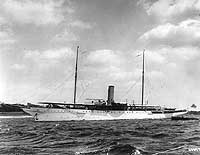
HMCS Beaver was an armed yacht that served in the Royal Canadian Navy during the Second World War. Originally named Aztec, the yacht was requisitioned for service in the United States Navy during the First World War under the same name. Returned to her owner in 1919, the yacht was laid up in 1931 following her owner's death. The vessel was purchased via a third party for service in the Royal Canadian Navy and after commissioning, Beaver was primarily used as a training ship with limited time as a patrol vessel. Following the war she was sold in 1946 and broken up for scrap in 1956.

An armed yacht was a yacht that was armed with weapons and was typically in the service of a navy. The word "yacht" was originally applied to small, fast and agile naval vessels suited to piracy and to employment by navies and coast guards against smugglers and pirates. Vessels of this type were adapted to racing by wealthy owners. The origin of civilian yachts as naval vessels, with their speed and maneuverability, made them useful for adaptation to their original function as patrol vessels. In the United States Navy armed yachts were typically private yachts expropriated for government use in times of war. Armed yachts served as patrol vessels during the Spanish–American War and the World Wars. In the latter conflicts, armed yachts were used as patrol vessels, convoy escorts, and in anti-submarine duties. In the United States, yachts were purchased from their owners with the owners given an option to repurchase their yacht at the close of hostilities.
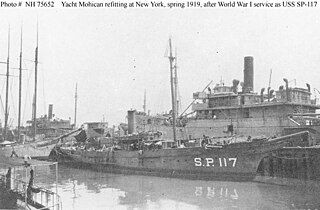
The third USS Mohican (SP-117), later USS SP-117, was an armed yacht that served in the United States Navy as a patrol vessel from 1917 to 1919.

HMCS Raccoon was an armed yacht that served in the Royal Canadian Navy during World War II. Purchased by the Royal Canadian Navy in 1940, the ship was originally known as the yacht Halonia. Used as a patrol vessel and convoy escort, the ship was sunk by the German submarine U-165 in the St. Lawrence River on 7 September 1942. Raccoon was escorting Convoy QS-33 at the time. The entire ship's crew was lost.
HMCS Courtenay was a Bangor-class minesweeper constructed for the Royal Canadian Navy during the Second World War. Entering service in 1942, Courtenay spent the entire war on the West Coast of Canada. The vessel was decommissioned in 1945 and sold for mercantile service in 1946. The fate of the vessel is uncertain.
HMCS Outarde was a Bangor-class minesweeper constructed for the Royal Canadian Navy during the Second World War. Entering service in 1941, the ship spent the entire war on the West Coast of Canada. Following the end of the war, the vessel was sold in 1946 for mercantile conversion and renamed Psing Hsin. In 1950 the vessel was sold again and renamed Content and remained in service until broken up for scrap in 1951.
HMCS Quatsino was a Bangor-class minesweeper constructed for the Royal Canadian Navy during the Second World War. Entering service in 1941, the minesweeper spent the entire war on the West Coast of Canada. Following the war, the vessel was sold for mercantile conversion in 1947 and renamed Chen Hsin. In 1950 the merchant ship was sold and renamed Concord before being broken up for scrap in 1951.
HMCS Husky was an armed yacht used for patrol and training purposes during World War II by the Royal Canadian Navy. The ship was constructed as the yacht Wild Duck in 1930 in Bay City, Michigan. Having several owners through the 1930s, the vessel was renamed Xania II. Acquired by the Royal Canadian Navy in 1940 for patrol, escort and training duties in Atlantic Canada, the ship was taken out of service at the end of the war and sold into commercial service. The vessel was purchased by the Port of New Orleans, Louisiana for use as an inspection ship. In 1967 the ship was sold again, renamed Aquarius No. 2 and used as a diving tender based in Honduras. In 1979 the vessel was acquired by American interests who brought the ship back to New Orleans and converted it to a floating restaurant.
HMCS Vison was an armed yacht of the Royal Canadian Navy during World War II. The vessel was acquired in 1940 for use as a patrol boat and later, as a training ship. In 1946, following the end of the war, Vison was sold into private ownership. The vessel was constructed as Avalon in 1931 by Pusey & Jones of Wilmington, Delaware, United States on behalf of Ogden L. Mills, the Secretary of the United States Treasury. During its service during World War II, Vison participated in the Battle of the Atlantic and the Battle of the St. Lawrence escorting convoys and defending them against German U-boats.
HMCS Otter was an armed yacht in service with the Royal Canadian Navy during World War II. Launched in 1921, the vessel was constructed as Nourmahal for Vincent Astor of New York as a pleasure yacht. He sold the vessel in the late 1920s and it was renamed Conseco. The Royal Canadian Navy, finding a lack of suitable vessels in Canadian ownership to be taken into naval service, sent Canadian yacht owners south to the United States to find those vessels. Conseco was acquired and brought north to Halifax, Nova Scotia where the vessel was converted to an armed yacht in 1940. Renamed Otter the ship participated in the Battle of the Atlantic, escorting convoys and patrolling the Canadian coast. On 26 March 1941, Otter suffered a catastrophic fire aboard that sank the armed yacht. Two officers and seventeen ratings died in the incident.
HMCS Grizzly was an armed yacht acquired by the Royal Canadian Navy during World War II for coastal patrol and anti-submarine defence. Constructed in 1909 as Machigonne, a yacht for William L. Douglas, the vessel was purchased by the United States Navy in 1917 for use as a patrol ship on the United States East Coast during World War I and named USS Machigonne (SP-507). Following the end of the war, Machigonne was demobilised and returned to service as a yacht.

HMCS Wolf was an armed yacht of the Royal Canadian Navy during World War II that saw service on the British Columbia Coast of Canada. Constructed in 1915 as the yacht Wenowah, with the US entry into World War I, the vessel was taken into United States Navy service as USS Wenonah (SP-165) as a patrol ship. The vessel escorted convoys between the United States and Europe and between Gibraltar and Bizerte, Tunis and Genoa, Italy. After the war, Wenonah was loaned to the United States Coast and Geodetic Survey for three and a half years before being sold to private interests in 1928. In private ownership, the vessel was renamed at least twice, including Stranger and Blue Water.
